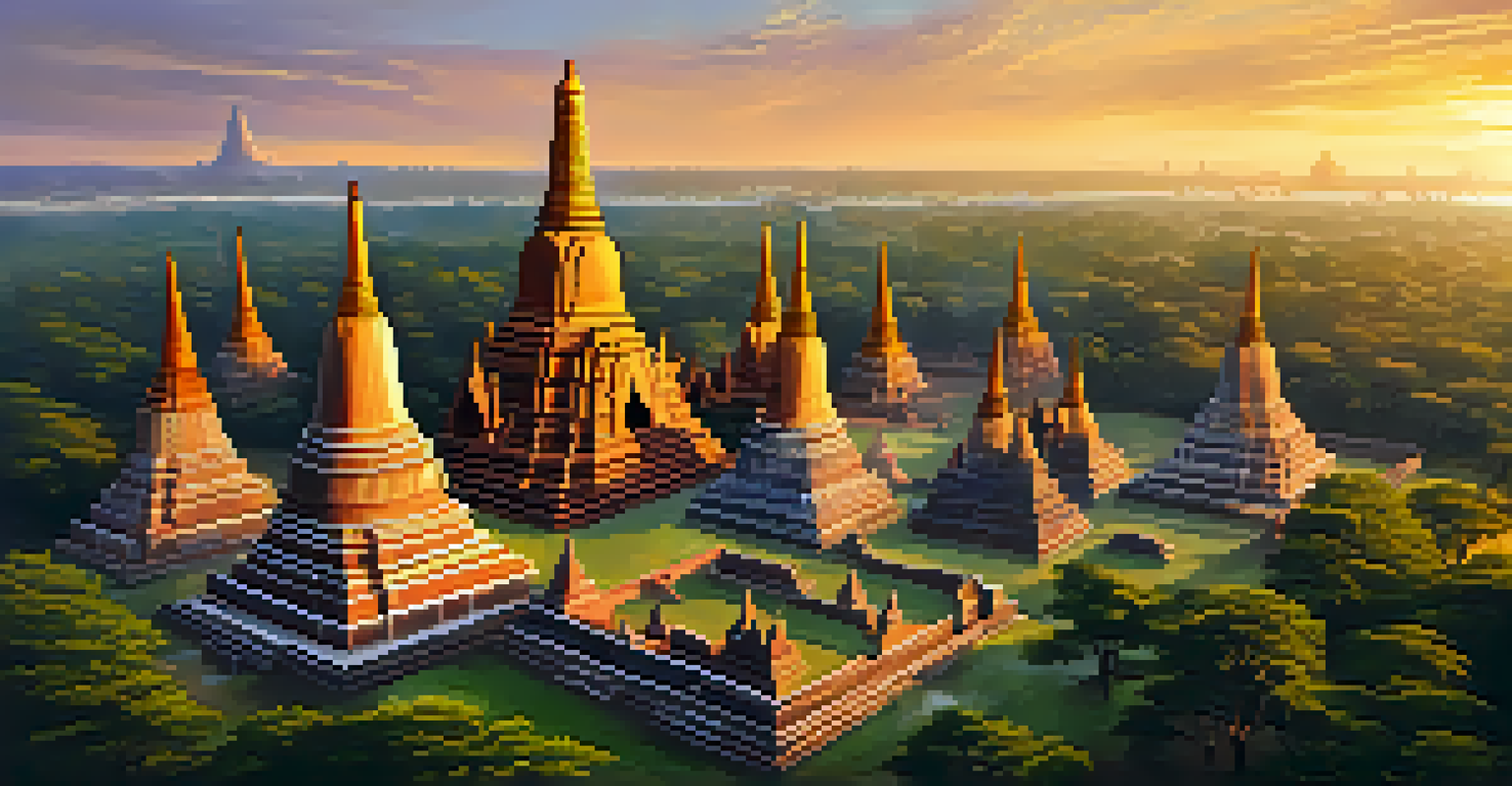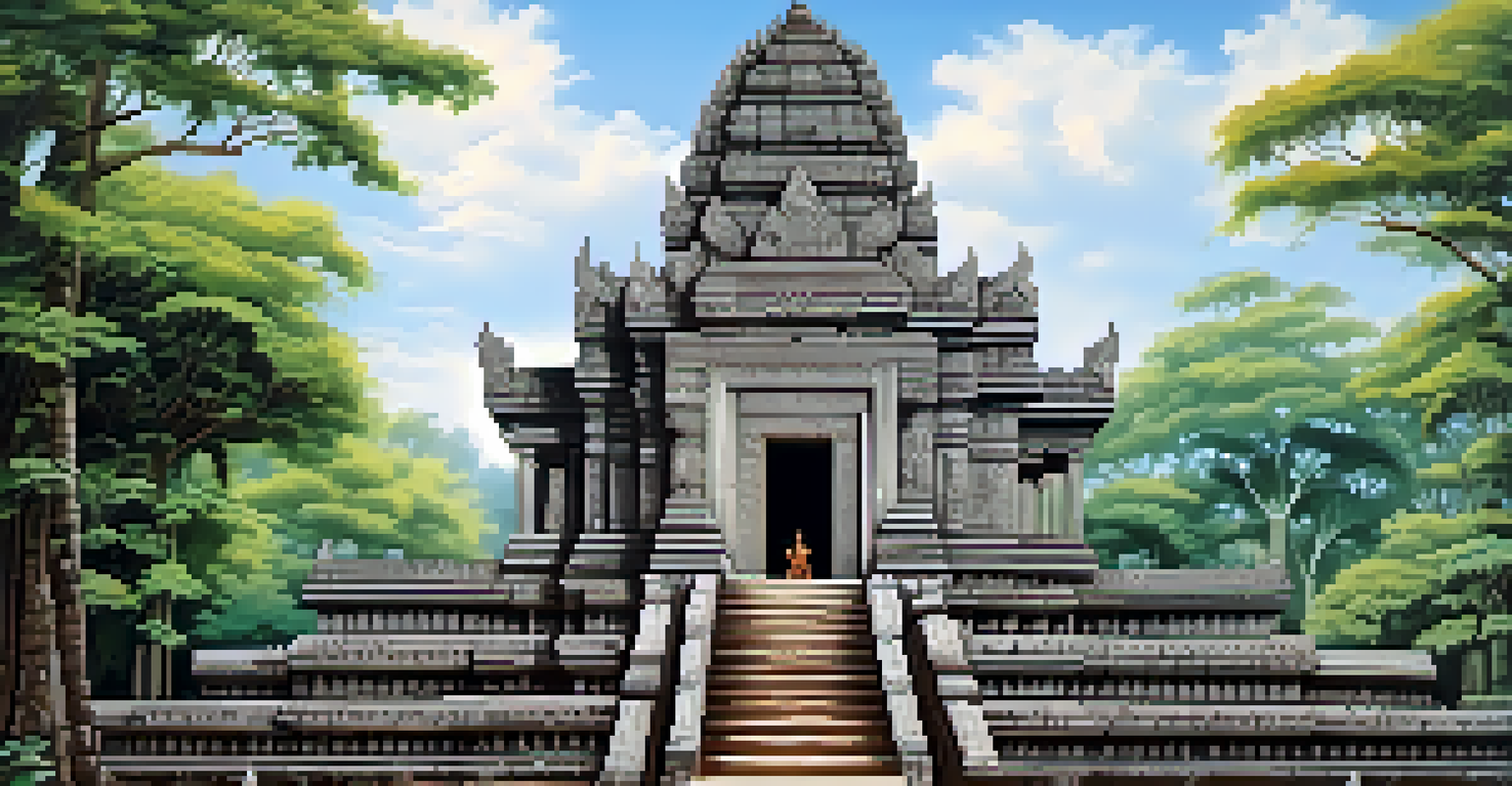Exploring Thailand's Ancient Ruins: Echoes of a Rich Past

The Allure of Thailand’s Ancient Ruins
Thailand is a treasure trove of ancient ruins that whisper stories of a glorious past. From the majestic temples of Ayutthaya to the intricate carvings at Sukhothai, each site offers a glimpse into the country’s rich history. These ruins are not just remnants of stone; they are echoes of cultures that once thrived, inviting visitors to step back in time.
To travel is to live.
Imagine walking among towering stupas and crumbling walls, feeling the weight of centuries in the air. The architecture reflects the artistry and spirituality of the civilizations that built them, often blending seamlessly with nature. This connection to the past creates a unique atmosphere, making each visit an unforgettable journey.
For travelers, exploring these ancient sites is more than just sightseeing; it’s an opportunity to connect with Thailand's heritage. Many sites are UNESCO World Heritage-listed, emphasizing their global significance. Embracing this rich history can enrich your travel experience, leaving lasting memories.
Ayutthaya: A Glimpse into the Former Capital
Ayutthaya, once a thriving capital of the Kingdom of Siam, is now a UNESCO World Heritage Site that enchants visitors with its ruins. Founded in the 14th century, it flourished for over 400 years before being destroyed in the 18th century. Today, the archaeological park features stunning temples like Wat Phra Si Sanphet and Wat Chaiwatthanaram, which echo the grandeur of its past.

As you wander through the remains, you can almost hear the hustle and bustle of a once-busy city. The impressive architecture showcases the influence of Khmer and Sri Lankan styles, reflecting the cosmopolitan nature of Ayutthaya. Photographers and history buffs alike find endless inspiration in the interplay of light and shadow across the ancient stones.
Thailand's Rich Ancient Heritage
Thailand's ancient ruins, from Ayutthaya to Sukhothai, offer a unique glimpse into the country's vibrant history and cultural evolution.
Visiting Ayutthaya offers a chance to appreciate both the beauty and tragedy of history. Many tours provide insights into the stories behind the ruins, making your exploration even more meaningful. It’s a reminder that even in destruction, there is beauty and resilience.
Sukhothai: The Birthplace of Thai Civilization
Sukhothai, another UNESCO World Heritage Site, is often regarded as the birthplace of Thai civilization. Established in the 13th century, it was the capital of the Sukhothai Kingdom and is famous for its innovative art and architecture. The Sukhothai Historical Park is a vast expanse of well-preserved ruins, including the iconic Wat Mahathat, with its stunning Buddha statues.
History is not a burden on the memory but an illumination of the soul.
As you stroll through the park, the serene lotus ponds and lush greenery enhance the beauty of the ancient structures. The site captures the essence of early Thai culture, showcasing the significant achievements in art, agriculture, and governance. It’s a place where history feels alive, and every ruin tells a story.
Visiting Sukhothai is like walking through a living museum, where you can appreciate the harmony between nature and architecture. The well-maintained paths make it easy to explore at your own pace, allowing for quiet reflection. It’s a perfect spot for those looking to immerse themselves in Thailand’s rich heritage.
Phimai: A Khmer Influence in Thailand
Located in northeastern Thailand, Phimai is home to one of the finest examples of Khmer architecture outside of Cambodia. The Phimai Historical Park features the impressive Phimai Temple, built in the 11th century as a Hindu sanctuary. Its intricate carvings and towering gopura (entrance) reflect the grandeur of Khmer artistry, making it a must-visit for history enthusiasts.
The temple complex is surrounded by a tranquil atmosphere, with lush gardens and ancient trees that invite exploration. Walking through the grounds, you can admire the remarkable stonework and imagine the vibrant ceremonies that once took place here. The site offers a unique glimpse into the cultural exchanges between Thailand and its neighbors.
The Influence of Buddhism
Buddhism significantly shapes the design and purpose of Thailand's ancient sites, creating sacred spaces that invite personal reflection and spiritual connection.
Phimai is often less crowded than other historical parks, allowing for a more intimate experience. This peaceful setting provides an ideal backdrop for photography or simply soaking in the history. It’s a hidden gem that showcases the rich tapestry of Thailand’s ancient heritage.
Wat Phra Kaew: The Temple of the Emerald Buddha
No exploration of Thailand’s ancient ruins would be complete without a visit to Wat Phra Kaew, located in the heart of Bangkok. Renowned as the Temple of the Emerald Buddha, it houses Thailand’s most revered religious artifact. The temple complex is a breathtaking blend of intricate architecture and vibrant colors, making it a spiritual and cultural landmark.
As you enter the temple grounds, you’re greeted by stunning murals and ornate golden stupas. The Emerald Buddha itself, carved from a single block of jade, is a sight to behold, draped in seasonal robes that are ceremonially changed. Visitors often find themselves captivated by the temple’s beauty and the deep sense of reverence it inspires.
Wat Phra Kaew is not just a tourist attraction; it’s a vital part of Thai identity and spirituality. Participating in the rituals and observing local customs can deepen your understanding of Thai culture. It’s a place where ancient tradition meets modern life, creating a unique experience for every visitor.
The Influence of Buddhism on Ancient Ruins
Buddhism has played a significant role in shaping Thailand's ancient ruins, with many temples built to honor the religion. The architectural styles and designs often reflect Buddhist beliefs and teachings, making these sites sacred spaces. As you explore, you’ll notice how the structures are oriented and embellished to symbolize various aspects of Buddhism, from enlightenment to the cycle of life.
For instance, the serene Buddha statues found in many temples embody the principles of peace and mindfulness. These images invite reflection and create a tranquil atmosphere that resonates with visitors. This spiritual connection adds depth to the experience of exploring ancient ruins, transforming it into a journey of personal discovery.
Preserving Historical Sites
As tourism grows, responsible practices and community engagement are essential for preserving Thailand's ancient ruins for future generations.
Engaging with the spiritual elements of these sites can enhance your appreciation of Thailand's cultural heritage. Whether through meditation, observing ceremonies, or simply taking in the surroundings, visitors often leave with a renewed sense of purpose. The influence of Buddhism is a reminder of the enduring power of faith and community.
Preserving Thailand’s Ancient Heritage
As tourism continues to grow, the importance of preserving Thailand’s ancient ruins cannot be overstated. Many organizations and government bodies are working diligently to protect these historical sites from the effects of time and human activity. Initiatives include restoration projects, educational programs, and sustainable tourism practices aimed at minimizing the impact on these treasures.
Visitors can play a crucial role in preservation efforts by practicing responsible tourism. Simple actions like staying on marked paths, respecting local customs, and supporting conservation initiatives can make a significant difference. By being mindful of your impact, you contribute to the longevity of these sites for future generations to enjoy.

In this way, each visit becomes an opportunity to honor the past while caring for the future. Engaging with local communities and learning about their preservation efforts can deepen your connection to the culture. It’s a shared responsibility that allows everyone to play a part in keeping Thailand’s ancient heritage alive.
Conclusion: Embracing the Echoes of the Past
Exploring Thailand's ancient ruins offers a profound connection to the country’s rich history and culture. Each site is a chapter in the story of a nation that has endured through centuries of change. As you walk among the remnants of temples and palaces, you can feel the echoes of the past guiding you forward.
Whether you're captivated by the artistry of the structures, the spiritual significance, or the stories they tell, these ancient ruins provide an enriching experience. They remind us of the importance of history in shaping our identity and values. Embracing this heritage fosters a deeper appreciation for the world around us.
So, pack your bags and set off on an adventure to uncover the beauty of Thailand’s ancient sites. Each visit is an opportunity to not only witness history but to become a part of it. In the echoes of these ruins, you’ll find stories that resonate, waiting to inspire your own journey.